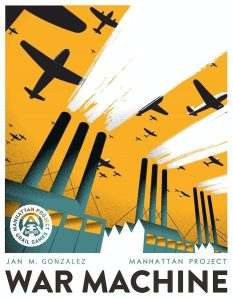 I first played The Manhattan Project back in 2014. Fairly early in my board gaming journey and I really enjoyed what it did with different types of workers. And the theme was unique and interesting—I did my science fair project in 5th grade about the building of the atomic bomb, so it’s always been a piece of history I found interesting.
I first played The Manhattan Project back in 2014. Fairly early in my board gaming journey and I really enjoyed what it did with different types of workers. And the theme was unique and interesting—I did my science fair project in 5th grade about the building of the atomic bomb, so it’s always been a piece of history I found interesting.
Then, in 2017 came Manhattan Project: Energy Empire. With a new game designer and exchanging regular worker placement for dice placement, it was well-received and largely considered to be better than the original.
But today we are looking at Manhattan Project: War Machine. Yet another new designer taking on the Manhattan Project series. And with a new publisher and a brand-new art style. Let’s see if it lives up to its predecessors.
Gameplay Overview:
Each player starts with a board to track their resources: food, steel, money, and victory points. You’ll begin with three dice, and you’ll start your turn rolling up to three times, but you must lock in at least one die with each roll. Each die has a face for the different types of workers: government, industrial, or commercial. There are also energy symbols that can be used in any sector if you have a regular worker there. And finally nuclear power faces which are effectively wild but give you pollution you’ll need to clean up later.
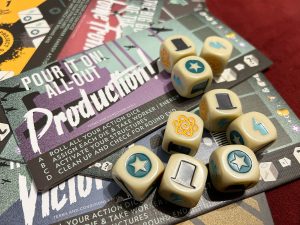
For each regular worker you place, you’ll have six different actions to choose from. They generally all boil down to generating resources, turning resources into points, or turning resources into expansions on your player board. After you take the action, all other players can also take an action in that sector, but a somewhat watered down version of it—fewer resources, more expensive building, etc… When you place the energy symbol, you instead just get the water-down version, but other players get nothing.
After placing your three dice you’ll then be able to assign the dice to your player board to activate structures you are building throughout the game. There are a variety of types of structures. Some activate once, others multiple times. Others will power up adjacent structures. And finally, some only provide additional end game scoring.
In addition to building structures, the other type of expansion is flipping your warehouse tiles to give you more dice each round or room for even more structures within your personal board.
The game ends after 6/5/4 rounds with 2/3/4 players. Points accumulated throughout the game are added to points from extensions and upgrades, as well as a hidden goal each player starts with. The player with the most points is, I suppose, ready for war.

Game Experience:
Two things about War Machine drew me in. First, the Manhattan Project line has thus far been solid. Second, the art is incredible. I love the propaganda poster-style art of the box and player boards. And big chunky dice don’t hurt either.
And then I realized this game isn’t really about the atomic bomb at all. I suppose the “War Machine” title should have given away that it’s more about stockpiling resources, but it’s not quite as gripping of a theme. Rather than doing research and mining uranium, I’m building shopping zones and a landfill. There is no doubt that the home front is important, but the theme really could have just as easily been city building.

Fine, I love city building too. And the idea of building an engine of structures that make other structures better is promising.
It’s just missing something to really increase the decision space in the game. You roll your dice and maybe get what you want and can lock them in. Or you don’t roll well and must deal with the result. You do have an option to spend two dice as a wild, allowing you to mitigate a disastrous roll, but at the cost of one of your actions. In a game where you have 12 actions in a four-player game, that’s a pretty high cost.
Generally, you’ll get a couple structures that give you more end game scoring for a particular type of resource and do your best to stockpile all those. But if you get a tile scoring VP for your coins and then you only roll government workers they can’t really help you out too much.
And just when you feel like you’ve had a few rounds and you have multiple options, the game ends. As with a lot of light-to-mid weight engine builder games, it doesn’t ramp up fast enough to give you big, exciting turns before you must put it all back in the box.

Final Thoughts:
Manhattan Project: War Machine offers a visually appealing package and a polished dice worker placement experience. But it misses out on strategic depth and the excitement of big turns you expect from an engine builder. The theme leans not just to managing your resources but almost entirely to swapping various resources for points takes it miles away from what made the series stand out.
If you are looking for an intro type of dice placement game you could certainly do worse. But if you are already familiar with Energy Empire you will likely be disappointed. However, it’s worth mentioning Energy Empire is coming from Grail Games with a new look similar to War Machine, so keep an eye out for that.
Final Score: 3 Stars – Love the new look, disappointed by the theme, and the game is fun but unexciting.
 Hits:
Hits:
• Love the art style and production
• Easy to explain and get into
Misses:
• Theme is quite different than other games in the series
• Game ends before you get to enjoy the engine you’ve built
• Limited decision space with only a few options for each die you’ve rolled




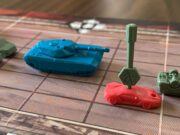




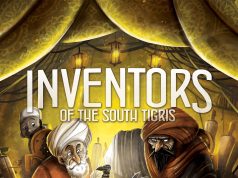
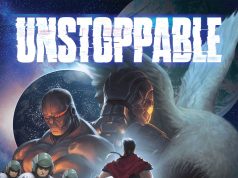











Thanks for your review! I’ve been considering this one, but have not decided yet. I thought MP:EE was very okay. No problems, but no fun either.